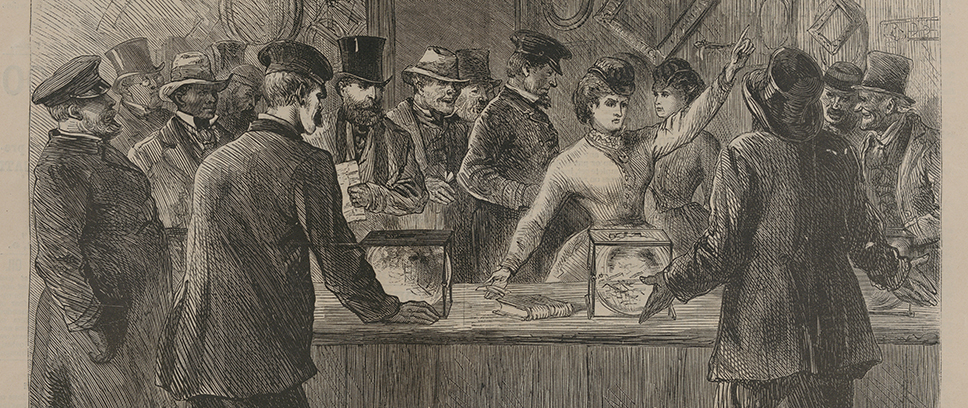
Victoria Woodhull and Karl Marx
Dr Antje Schrupp | 3 March 2022
In 1871, the American journalist, spiritualist, socialist and suffragette Victoria Woodhull (1838–1927) joined the New York “Section 12” of the International Workingmen’s Association. Among her main topics were women’s right to vote and social reform, but also women’s sexual freedom. Karl Marx sharply opposed her positions, as Dr Antje Schrupp explains in her blog on the exhibition “Karl Marx and Capitalism”.
The labour leaders in the USA were worried: “We don’t want people to take her ridiculous ideas for the views of this society,” wrote the secretary of the central committee of the International, Friedrich Bolte, to Karl Marx and the General Council in London in spring 1872. “The nonsense she’s talking about, women’s suffrage and free love, might be considered sometime in the future, but the question that interests us as workers is that of labour and wages!”
What got the representatives of the organised labour movement into such a turmoil was Section 12 of the New York International. It was namely under the leadership of Victoria Woodhull, the scandal-ridden public personage who made headlines at the time because she wanted to be the first woman ever to run for president in the upcoming elections in November 1872. To make matters worse, Woodhull was not one of the respectable, middle-class women’s rights campaigners. A few months earlier, she had proclaimed in the overcrowded Steinway Hall in Manhattan before an audience of thousands: “Yes, I am a Free Lover. I have an inalienable, constitutional and natural right to love whom I may, to love as long or as short a period as I can; to change that love every day if I please …!” The moralisers went berserk.
One can see the personalities of Victoria Woodhull and Karl Marx as opposite types of representatives of the socialist, proletarian struggle. Not only the obvious difference that she was a woman and he a man at a time when gender equality was not yet an issue. Marx’s concern was entirely focused – critique of capitalism and liberation of the working class from its economic plight. Woodhull, by contrast, addressed a broad agenda. She wanted to change not only economy and politics, but culture, morals, values, gender relations as well. She was not only a socialist, but also a feminist, spiritualist, social reformer.
And capitalist. As the first woman ever, she had opened a brokerage firm on Wall Street together with her sister Tennessee. The capital came from the railway magnate Cornelius Vanderbilt, who cut her in on his profits because of her allegedly clairvoyant stock exchange tips, which in reality came from insider knowledge accrued from the redlight district.
The biggest difference between Woodhull and Marx is no doubt their social background. That of Marx was bourgeois, Woodhull on the other hand came not only from the lower class, but from its seamier side. She was born on 23 September 1838, some twenty years after Marx, in a tiny town called Homer in Ohio as the seventh child of Annie and Buck Claflin. Her mother was a religiously motivated spiritualist, her father a con artist. The Claflin family was not only poor, but what was then known as “unrespectable”. It corresponded almost exactly to what Marx had called the lumpenproletariat: no class consciousness, no work ethic, no ambition to rise into the bourgeoisie.
At age 15, Victoria married a drunkard, tramped through the saloons of San Francisco as a cigar girl during the gold rush, brought two children into the world (one of them severely mentally disabled), and made a career as a fortune teller and faith healer in St. Louis. The turning point in her life came when she fell in love with a Civil War veteran in 1868, who introduced her to the American reform movement. From that time on, she put all of her energy into making her voice and the collected experience of her life heard on the political stage of her time. She took up the concerns of beaten women, destitute families with many children, sex workers, men and their families traumatised by war, women with unwanted pregnancies, social outcasts of all kinds. She wrote newspaper articles, held speeches, composed petitions, established political relationships, founded a weekly newspaper. For us today, she is truly a stroke of luck, for among the sources of the 19th century there are otherwise almost no original voices that didn’t come from the bourgeois milieu, let alone female voices.
In today’s terminology, Victoria Woodhull could be understood as a representative of intersectional feminism. She wanted to get the suffragettes to fight not only for the right to vote – a typical middle-class concern at the time – but also for a reform of marital law, access to abortion and contraceptives, more economic equality. When white feminists wanted to play off women’s right to vote against that of Black men, Woodhull submitted an unconventional suggestion by declaring that women in the USA had formally long since had the right to vote. In fact, she was able to personally present this paper, which became known as the “Woodhull Memorial”, to the House Committee on the Judiciary in Washington on January 1871.
She never let herself be co-opted by any movement. The suffragettes had barely begun to become interested in her when she organised in New York a huge funeral march for the victims of the Paris Commune. She constantly challenged all sides. Ultimately, it must be said, without success. For in the end, both the women’s movement and the labour movement distanced themselves from Victoria Woodhull. At the congress in The Hague in September 1872, Section 12 was expelled from the International, and the suffragettes also extinguished the memory of their singular pioneer for a long time. It was only at the end of the 20th century that researchers rediscovered Woodhull. In the year 2001, she finally earned a place in the American “National Women’s Hall of Fame”.
Fortunately. For even today the ideas and analyses of Victoria Woodhull are a terrific inspiration for anyone looking for liberal-minded models in the struggle against authority in all its different forms.
Picture: Mrs. Woodhull asserting her right to vote, In: Harper’s Weekly (778), Drawing: H. Balling, New York, November 25, 1871, Reproduction, Göttingen, Staats- und Universitätsbibliothek Göttingen
 © Private |
Dr Antje SchruppDr Antje Schrupp is a political scientist and journalist and lives in Frankfurt am Main. She did her Ph.D. on feminist socialists in the First International and concentrates above all the history of political ideas of women. In 2002 her book “Das Aufsehen erregende Leben der Victoria Woodhull” (The sensational life of Victoria Woodhull) was published, the first German-language biography of Woodhull. |